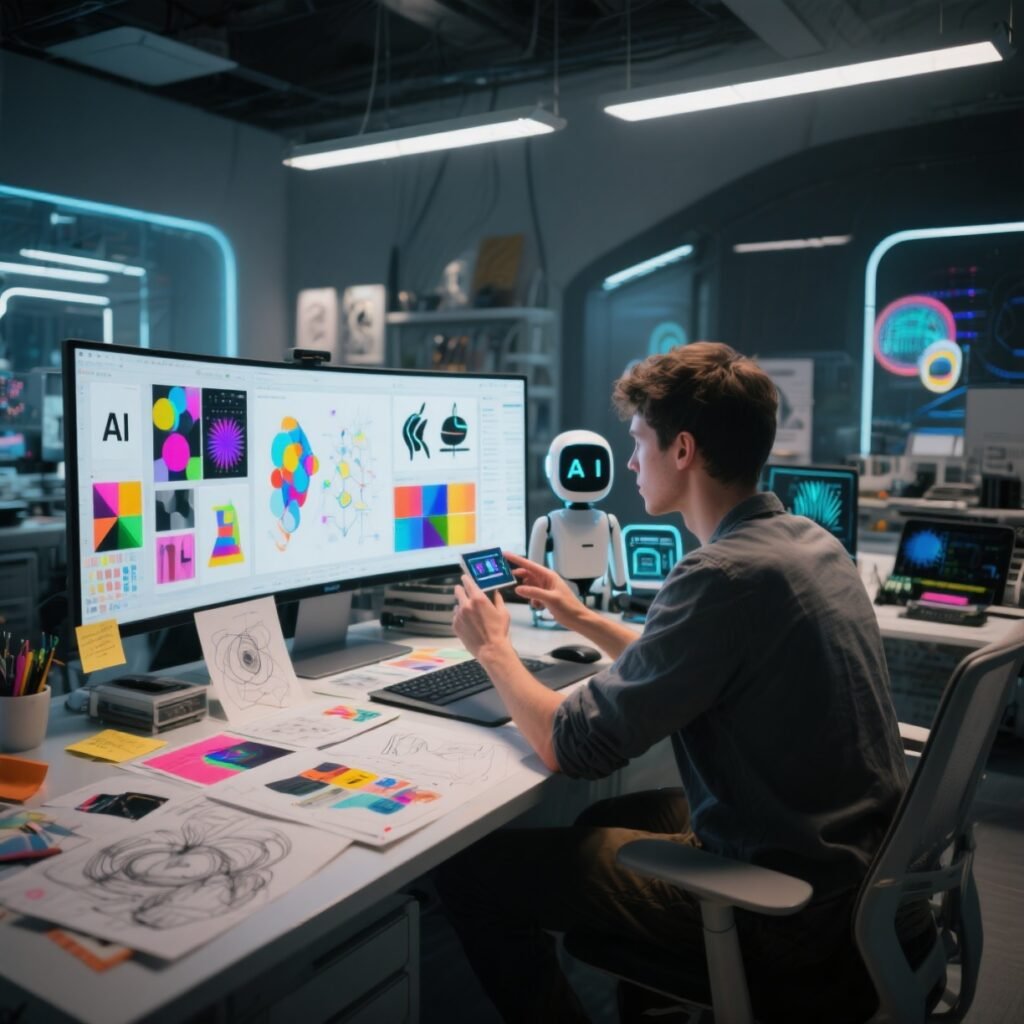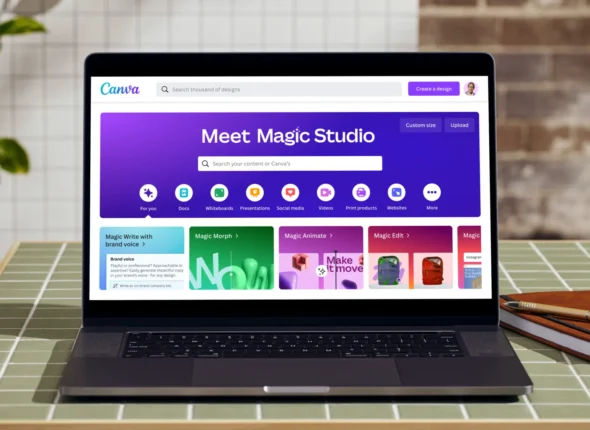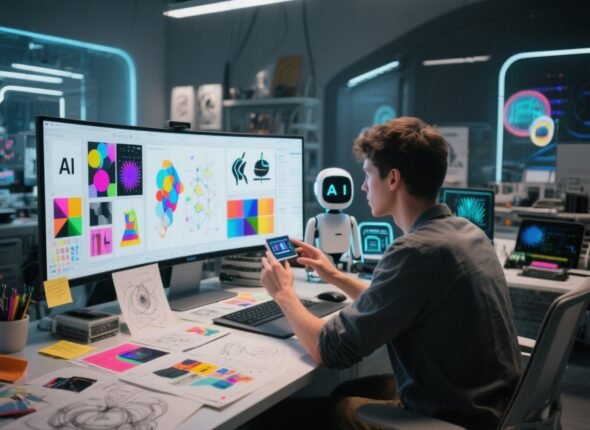
The Rise of AI as a Designer: Is it Time to Embrace the Future?
In the ever-evolving world of design, it’s no surprise that technology has found its way into the creative process. With the advent of artificial intelligence (AI), designers are now facing a new frontier—one that challenges traditional boundaries and offers a vast array of possibilities. But is AI really a valuable tool for design, or is it a threat to the artistry and human touch that define the profession?
Let’s explore how AI is shaping the world of design, the opportunities it presents, and the potential pitfalls we need to watch out for.
AI: The New Design Partner?
At first glance, it might seem like AI and design don’t belong together. After all, design is often thought of as a deeply personal and human-driven process. It’s about more than just functionality—design evokes emotions, tells stories, and creates connections. So how could a machine possibly be good at something so inherently human?
The truth is, AI is not here to replace designers. Rather, it’s here to assist, complement, and enhance the creative process. Think of AI as a highly skilled assistant: it can handle the repetitive tasks, crunch massive datasets for inspiration, or even generate design iterations in seconds—giving designers more time to focus on the artistic and conceptual aspects of their work.
For instance, AI can analyze trends and help generate design ideas based on popular styles, color schemes, or typography. It can even suggest layout structures, or assist in creating personalized content for specific audiences. These AI tools don’t just speed up the process; they open up new realms of creativity by introducing ideas that a human designer might never have considered.
How AI is Changing the Design Workflow
AI isn’t just lurking in the background—it’s already making its presence felt in a number of ways. Let’s break down some key areas where AI is already enhancing the design process:
Automating Routine Tasks: Tasks like resizing images, optimizing layouts, or creating variations of a design can eat up valuable time. AI tools can automate these processes, saving designers countless hours of repetitive work. For example, tools like Canva and Adobe Sensei use AI to streamline image editing, suggesting improvements and automating tasks that once required hours of manual input.
Personalization at Scale: AI’s ability to analyze data means it can create hyper-personalized designs at scale. Websites, apps, and digital content can be tailored to individual users, adapting layouts, colors, and messaging based on their preferences and behaviors. This leads to a more engaging user experience and makes it easier to cater to niche audiences.
Inspiration and Idea Generation: Stuck in a creative rut? AI can be a goldmine for inspiration. With its vast access to design databases, AI can generate mood boards, suggest color palettes, and offer design elements based on current trends or specific keywords. Tools like Runway ML and Artbreeder allow users to experiment with AI-driven creative outputs—blurring the line between human creativity and machine-generated content.
Design Prototyping: In user experience (UX) design, AI can help create prototypes quickly. AI-powered platforms like Figma and Sketch incorporate machine learning to speed up layout generation, navigation flows, and even predict user behavior—giving designers more time to focus on perfecting the experience rather than getting bogged down in wireframes and testing.
The Pros: Why AI Could Be a Designer’s Best Friend
While AI may seem intimidating at first, it’s hard to deny the potential benefits it brings to the table:
Faster Iterations: AI tools can generate hundreds of design variations in a fraction of the time it would take a human designer to do the same. This allows designers to experiment freely and quickly, testing out different approaches before committing to a final design.
Increased Accessibility: Not all designers are technical experts. With AI-powered tools, even beginners can create polished, professional-level designs with little experience or knowledge. This democratizes design and enables more people to enter the creative field.
Augmented Creativity: AI is great at processing patterns, trends, and data in ways humans can’t always keep up with. This means AI can propose new creative directions that a designer may not have thought of, acting as an augmentation to human creativity rather than a replacement.
The Cons: Potential Pitfalls and Concerns
That being said, there are also valid concerns about AI in design. Here are a few of the most significant challenges:
Loss of Human Touch: One of the core principles of design is its ability to convey emotion and human experience. Can an AI truly understand the nuances of human culture, history, and emotion in the same way a designer can? While AI can generate aesthetically pleasing designs, it may struggle to capture the essence of what makes design truly meaningful.
Overreliance on AI: If designers begin to rely too heavily on AI for idea generation or design execution, we may lose some of the originality and authenticity that defines good design. AI is a tool, but it shouldn’t replace the critical thinking and decision-making that comes from a human designer’s unique perspective.
Job Displacement: With AI becoming more integrated into the design industry, there’s fear that some design jobs may be at risk. While AI isn’t replacing designers, it’s important for those working in creative fields to adapt and find ways to leverage these tools effectively. Designers who are open to working with AI, rather than against it, will likely find themselves in a better position moving forward.
Ethical Concerns: As AI starts to take on more creative roles, questions about authorship and ownership of designs will inevitably arise. If AI generates a design, who owns the rights? The creator of the AI? The person who used it? Or is it a collaborative effort? As the boundaries between human and machine-created art blur, legal and ethical considerations will become increasingly important.
How to Prepare for an AI-Powered Future in Design
The future of design is undoubtedly tied to AI, but this doesn’t mean traditional design skills are obsolete. In fact, learning to incorporate AI into your workflow could make you a more versatile and competitive designer. Here are a few ways to prepare for the AI-driven design future:
Learn to Use AI Tools: Start by familiarizing yourself with AI-powered design tools and platforms. Adobe Sensei, Daz 3D, and Deep Dream Generator are a few examples where AI is already making an impact. Experiment with these tools to see how they can complement your existing design skills.
Stay Creative and Curious: AI can handle the repetitive tasks, but it’s still up to you to bring the creativity. Keep honing your creative thinking and problem-solving abilities. Remember, AI can enhance your work, but it won’t replace the human spark that makes your designs unique.
Be Open to Collaboration: Treat AI as a collaborator, not a competitor. By working together with AI, you can push the boundaries of design and discover new ways of thinking that weren’t possible before.
Final Thoughts
AI is undeniably changing the world of design, offering new ways to work, create, and innovate. While it’s important to consider the ethical, creative, and job-related challenges it brings, the potential for AI to enhance the design process is immense. As the lines between human and machine creativity continue to blur, one thing is clear: the future of design will be a partnership between human ingenuity and artificial intelligence.
So, are you ready to embrace the future of design?
The Ultimate Guide to Becoming a Freelancer in India: Your Step-by-Step Journey
- July 24, 2025
- Com 0
The Ultimate Guide to Becoming a Freelancer in India: Your Step-by-Step Journey Are you considering freelancing in India? If so,...
Canva: The Ultimate Design Tool and Its Latest Top 10 AI-Powered Features
- July 24, 2025
- Com 1
Canva: The Ultimate Design Tool and Its Latest Top 10 AI-Powered Features In today’s world, graphic design doesn’t have to...
The Rise of AI as a Designer: Is it Time to Embrace the Future?
- July 24, 2025
- Com 1
The Rise of AI as a Designer: Is it Time to Embrace the Future? In the ever-evolving world of design,...




